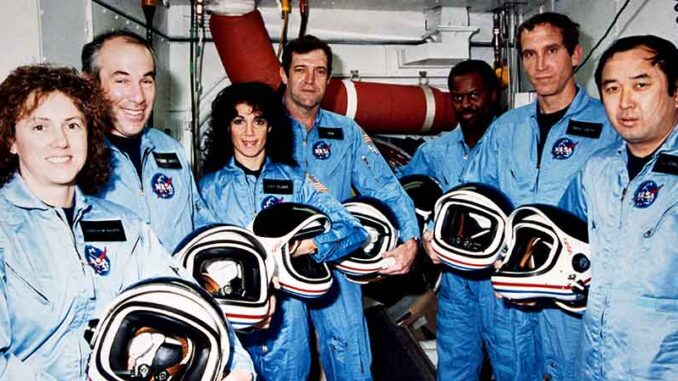
On January 28, 1986, NASA’s Space Shuttle Challenger exploded, killing all seven who were on-board, including the first civilian into space. Amid the wave of tributes in recent weeks, btw remembers this tragedy and points out some lessons.
Background
In 1972, President Richard Nixon announced the development of NASA’s space shuttle program. Unlike previous missions, the new orbital spacecraft was designed to be reusable. The first of five test launches, by the shuttle Enterprise, began in 1977. From 1981 to 2011 NASA launched 135 total missions on five different shuttle spacecraft: Columbia, Challenger, Discovery, Atlantis, and Endeavour. The Space Shuttle Challenger made its maiden flight on April 4, 1983. It averaged three missions a year, for a total of nine missions.
What Happened?
The Challenger was originally scheduled for liftoff on January 22, 1986, but equipment problems and bad weather pushed the date back. The John F. Kennedy Space Center, located along the east coast of central Florida, is the launch site for NASA’s missions. Its typically mild winters means that cold weather is not usually an issue during liftoff. (The lowest temperature on any previous liftoff had been 53 degrees.) On the morning of January 28, however, it was around 35 degrees, which caused ice to form on the launch pad. The flight was delayed again, but only by a few hours.
A little over a minute into the launch, flight commander Francis (Dick) Scobee radioed that everything was okay. Seconds later, however, spectators witnessed smoke and what appeared to be a fireball in the sky. Mission control reported that there had been an obvious malfunction. The world reacted to the tragedy with shock and sadness. President Ronald Reagan was scheduled to deliver his annual State of the Union speech that evening. Instead, he addressed the nation about the Challenger accident.
Aftermath
The Challenger disaster was NASA’s second fatal spaceflight failure. (The first, in 1967, involved three Apollo 1 astronauts who died in a launch pad fire while aboard their capsule.) But the Challenger was an accident witnessed live by the public on television. Over the years, attention on shuttle flights had begun to decline. But the NASA’s Teacher in Space Project had generated significant media attention. Social Studies teacher, Christa McAuliffe of New Hampshire had been selected from more than 11,000 applicants.

After the disaster, the shuttle program was halted for several months. President Reagan formed a special commission to investigate the accident. Made up of 14 people, including former astronauts Neil Armstrong and Sally Ride, and Nobel Prize-winning physicist Richard Feynman, the Rogers Commission (named for U.S. Secretary of State William Rogers, who led the effort) spent the next several months collecting and examining evidence. The team laid out its findings in an official report. The failure of an O-ring was named as the official cause of the Challenger explosion. These mechanical seals are supposed to prevent hot gases from making contact with any tank containing fuel. The failure was caused by a design flaw.
The commission also named at least two significant contributing factors. The low temperature on the day of the accident compromised the effectiveness of the faulty O-rings. NASA engineers had warned officials of the risk and reportedly refused to sign the launch recommendation report required for liftoff. The fact that the engineers were ignored and decision made to go ahead with the launch, was another significant contributing factor.
Related Links
- Learn more about how NASA honored the crew of the Challenger, and other NASA astronauts who have died in space operations.
- Read about the NASA memorial dedicated this past summer to honor fallen astronauts.
Dig Deeper Do some biographical research on at least one of the seven members who died aboard the Challenger. Write a least one paragraph detailing his or her qualifications for the mission and the training he or she went through.
